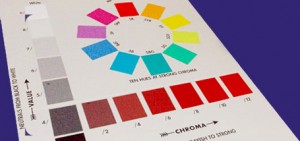
Albert Munsell again returned to his artist roots to develop the color chroma scale, which refers to the strength (also known as saturation) or weakness of a given color. The chroma color attribute completes Munsell’s vision of a systematic means for effectively communicating and teaching color – a system that he modeled after what he saw as a three-dimensional system of teaching music, where each sound is comprised of three elements—pitch, intensity and duration. Having developed the Munsell hue circle, and the neutral value scale, Munsell completed his three dimensional color model with chroma.
Munsell said of his chroma attribute, “Flat diagrams showing hues and values, but omitting to define chromas, are as incomplete as would be a map of Switzerland with the mountains left out or a harbor chart without indications of the depths of the water.” Color chroma was also the attribute that led to Munsell’s color tree. Just as the tree branches run perpendicular to the trunk of the tree, so too does the chroma scale. Color families (color hue) that approach the lightest and darkest parts of the neutral axis are less chromatic or saturated than their mid-value range counterparts. Using the tree metaphor, the “limbs” of less chromatic colors would not extend very far from the neutral axis or “trunk.”
Munsell’s Color Order System Was Built to Last
Munsell’s hue, value and chroma three-dimensional color order system not only made it easier to visualize color, but also the relationship of colors to each other. This important distinction not only improves color communication, but also enables artists, designers and color technicians to properly harmonize color.
Another important distinction of Munsell’s color system is that it wasn’t limited to the color technology of the time. The system was inherently designed to accommodate new and more highly pigmented colors as technological innovation occurred. In fact, Munsell himself said, “It [Munsell Color Order System] includes and arranges all color sensations on a measured foundation, even providing for still stronger colors, should science discover them.”
A System of Color Rooted in Art and Science
So there you have it. The Munsell Color Order System… where art and science intersect and standing right in the middle is Albert H. Munsell. His life’s work beautifully summarized in his own words:
The possibilities of the system are very great. It possesses elements of simplicity and attractiveness. It gives one almost unconsciously power of color discrimination. It provides on only a rational color nomenclature, but also a system of scientific importance, and of practical value.
Color anarchy is replaced by systematic color description.
–Professor A.H. Munsell
Learn about the first two steps towards color order, “color wheel charts” and “color value scale.”
References:
Munsell, A.H., ed. 12, 1971. A Color Notation. Baltimore, MD: Munsell Color Company.



[…] and stepping horizontally towards the surface of the space, hues gradually change from gray to full chroma (intensity or purity of the […]
[…] from low to high chroma. […]
[…] colors like red, orange, yellow, etc. Value – the lightness or darkness of a color and Chroma – saturation or brightness of a […]
[…] on the colored diagram already referred to, where several steps of Yellow are shown printed on the scale of Chroma. This dimension of Chroma is written in a color formula by means of a numeral below a line, which […]